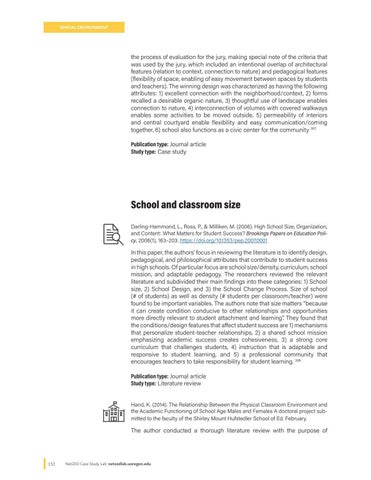SPATIAL ENVIRONMENT
the process of evaluation for the jury, making special note of the criteria that was used by the jury, which included an intentional overlap of architectural features (relation to context, connection to nature) and pedagogical features (flexibility of space, enabling of easy movement between spaces by students and teachers). The winning design was characterized as having the following attributes: 1) excellent connection with the neighborhood/context, 2) forms recalled a desirable organic nature, 3) thoughtful use of landscape enables connection to nature, 4) interconnection of volumes with covered walkways enables some activities to be moved outside, 5) permeability of interiors and central courtyard enable flexibility and easy communication/coming together, 6) school also functions as a civic center for the community 307. Publication type: Journal article Study type: Case study
School and classroom size Darling-Hammond, L., Ross, P., & Milliken, M. (2006). High School Size, Organization, and Content: What Matters for Student Success? Brookings Papers on Education Policy, 2006(1), 163–203. https://doi.org/10.1353/pep.2007.0001
In this paper, the authors’ focus in reviewing the literature is to identify design, pedagogical, and philosophical attributes that contribute to student success in high schools. Of particular focus are school size/density, curriculum, school mission, and adaptable pedagogy. The researchers reviewed the relevant literature and subdivided their main findings into these categories: 1) School size, 2) School Design, and 3) the School Change Process. Size of school (# of students) as well as density (# students per classroom/teacher) were found to be important variables. The authors note that size matters “because it can create condition conducive to other relationships and opportunities more directly relevant to student attachment and learning”. They found that the conditions/design features that affect student success are 1) mechanisms that personalize student-teacher relationships, 2) a shared school mission emphasizing academic success creates cohesiveness, 3) a strong core curriculum that challenges students, 4) instruction that is adaptable and responsive to student learning, and 5) a professional community that encourages teachers to take responsibility for student learning. 308 Publication type: Journal article Study type: Literature review Hand, K. (2014). The Relationship Between the Physical Classroom Environment and the Academic Functioning of School Age Males and Females A doctoral project submitted to the faculty of the Shirley Mount Hufstedler School of Ed. February.
The author conducted a thorough literature review with the purpose of
152
NetZED Case Study Lab netzedlab.uoregon.edu

